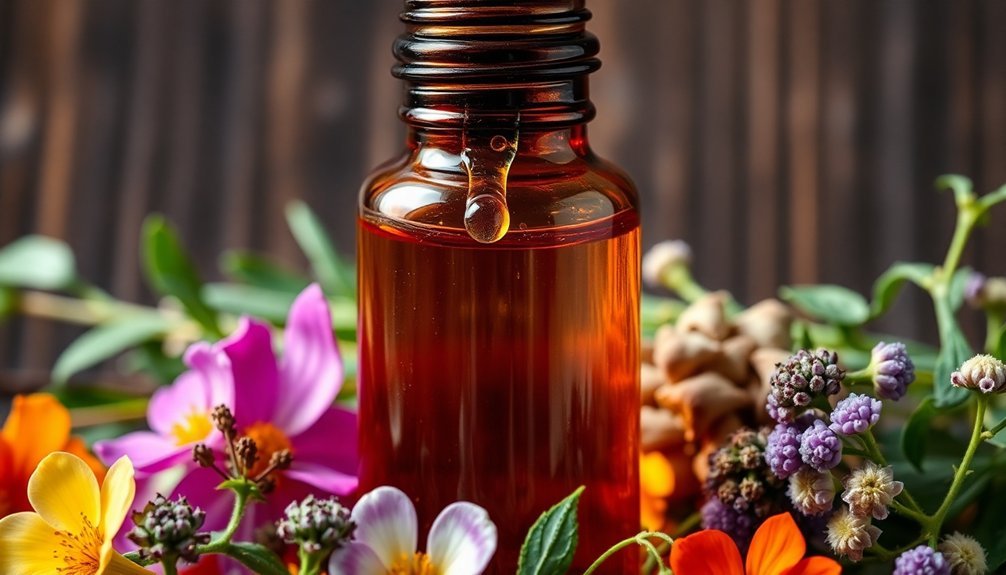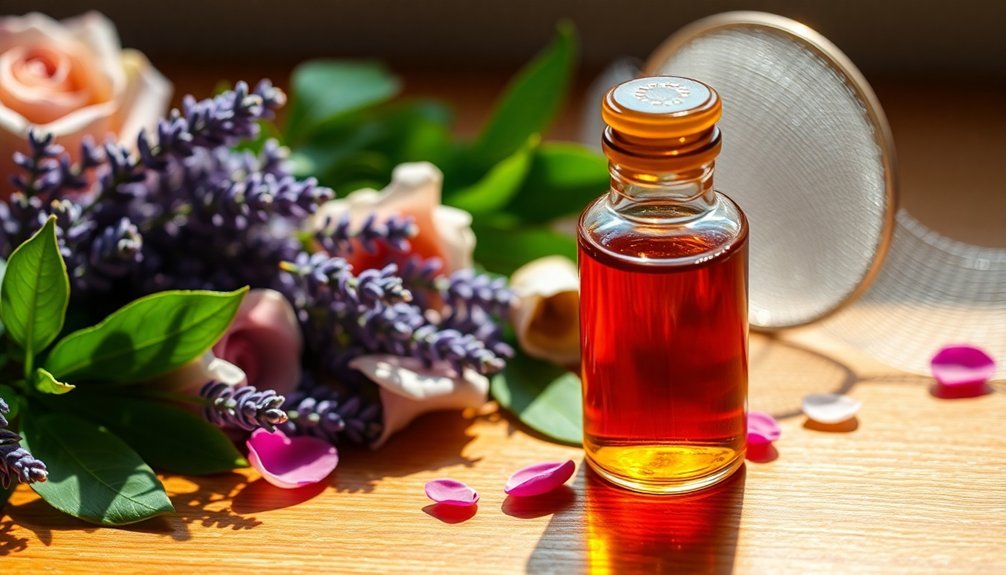To create a perfect botanical perfume tincture, you'll need to start with premium organic materials sourced from renowned growing regions and harvested at peak potency. You must properly prepare and process your botanicals, choose the right solvent mix of alcohol or glycerin, and master the art of maceration. Your attention to aging times and careful filtering techniques will determine the final clarity and complexity. The secrets to achieving crystal-clear, aromatic results await in the details below.
The Art of Selecting Premium Botanical Materials

When crafting botanical perfumes, selecting premium materials serves as the foundation for creating exceptional fragrances.
You'll want to focus on organic and wildcrafted botanicals that are sustainably harvested from renowned regions known for their superior quality. For instance, sourcing roses from Bulgaria or Morocco can make a significant difference in your final product's aroma.
Pay close attention to seasonal variations, as they directly impact the quality and scent profile of your botanical materials. Small batch blending ensures the optimal freshness and potency of each botanical ingredient.
It's essential to use reliable flower identification guides to guarantee you're working with safe, non-poisonous plants.
Remember to take into account the geographical origin of your materials, as certain regions produce botanicals with distinct characteristics.
Essential Steps in Material Preparation and Processing
Before diving into the botanical tincturing process, you'll need to master several critical preparation steps that guarantee ideal extraction and fragrance quality.
Start by collecting your plant materials after morning dew has dried, ensuring maximum fragrance concentration. You'll want to weigh your materials precisely and measure your menstruum according to specific ratios. For fresh herbs, maintain a 1:2 ratio with your chosen menstruum for optimal extraction.
Process your botanical materials thoroughly by:
- Finely chopping or blending in a Vitamix to release essential oils
- Combining with the measured menstruum in a sterilized jar
- Ensuring complete saturation of plant material with alcohol or glycerin
Store your mixture in a cool, dark place, allowing it to macerate for several weeks.
Don't forget to label your jar with detailed information and shake it periodically.
After straining, you may need to age your tincture for up to six months for optimal results.
The Role of Quality Solvents in Tincture Creation

Quality solvents play a central role in transforming your botanical materials into vibrant, aromatic tinctures.
You'll want to choose between ethanol, water, or a combination of both as your primary solvents, depending on which plant compounds you're targeting. Ethanol excels at extracting alkaloids and resins, while water pulls out minerals and carbohydrates.
When selecting your solvent, consider its polarity to match your desired plant compounds, and opt for organic grain or grape alcohol to guarantee purity. Similar to essential oil distillation, the extraction process requires careful attention to maintain compound integrity.
You'll find that quality solvents not only extract effectively but also help extend your perfume's longevity and fix fragrance notes, particularly important for volatile citrus oils.
Remember that proper solvent selection affects everything from the extraction process to the final product's stability and consistency.
Mastering the Maceration and Aging Process
Mastering the maceration and aging process requires careful attention to both time and technique. You'll need to start with semi-dried flowers that retain their fragrance while being free from excess moisture.
Place these materials in a glass container, cover them with your chosen alcohol solvent, and seal it tightly to prevent oxidation.
For ideal results, consider these essential steps:
- Store your container in a cool, dark place for at least several weeks
- Gently agitate the mixture periodically to enhance extraction
- Monitor temperature, keeping it below 30°C, even when using ultrasonic methods
The aging period is vital for developing complexity. You'll find that longer maturation times, up to six months, allow the fragrance compounds to harmonize, resulting in a more refined and lasting scent profile.
During this time, chemical reactions naturally occur, creating a richer, more nuanced perfume.
Fine Filtering Techniques for Crystal Clear Results

To achieve a pristine botanical perfume tincture, proper filtering techniques are essential for removing all traces of plant material and sediment.
You'll need a funnel lined with double-layered muslin cloth or unbleached coffee filters, along with clean dark glass bottles for storage.
Pour your tincture slowly through the filters, allowing it to drip naturally to minimize sediment disturbance. If you're working with dense plant material, wear latex gloves to gently squeeze out remaining liquid, then filter again.
For ideal clarity, you can use multiple filter layers or try filters with different micron sizes.
Don't forget to perform visual checks throughout the process. If you notice any cloudiness, repeat the filtering until you achieve crystal clear results.
Let your filtered tincture breathe briefly to enhance its botanical characteristics before storing.
Frequently Asked Questions
How Long Does a Properly Stored Botanical Perfume Tincture Typically Last?
Your botanical perfume tincture will last 3-5 years when you store it properly in a cool, dark place. You'll notice it'll evolve over time but won't spoil if you've used high-quality ingredients.
Can Different Botanical Tinctures Be Safely Combined After They're Fully Prepared?
Yes, you can safely combine different botanical tinctures after preparation, but you'll need to test for allergies first and limit your combinations. Start with 2-3 tinctures and gradually add more if desired.
What Signs Indicate a Tincture Has Gone Bad?
You'll know your tincture's spoiled if you notice cloudiness, sediment, mold, strange odors, or color changes. Watch for thickening, separation, or loss of fragrance. Don't use if it smells sour or off.
Are There Specific Seasonal Considerations When Harvesting Materials for Tinctures?
You'll want to harvest flowers in their peak blooming season, herbs in spring/summer, citrus peels in winter, and wild grasses in late spring. Always pick after morning dew dries but before midday.
Does Ambient Temperature Affect the Quality of the Tincturing Process?
Yes, ambient temperature greatly affects your tincturing process. You'll get the best results keeping temperatures between 15-25°C, as higher temps can degrade delicate compounds while cooler conditions help preserve botanical aromatics.
In Summary
You've learned the key elements that make a perfect botanical perfume tincture – from selecting premium materials to mastering the final filtration. By focusing on quality ingredients, proper preparation, and patient aging, you'll create something truly special. Remember, it's the attention to detail in each step that transforms simple botanical materials into an exquisite aromatic tincture you'll be proud to wear or share.





Leave a Reply